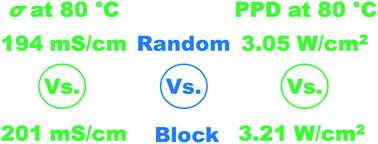Poly(norbornene) anion conductive membranes: homopolymer, block copolymer and random copolymer properties and performance†
Abstract
It has previously been shown that phase-separated block copolymers with non-ion conducting (hydrophobic) blocks and ion conducting (hydrophilic) blocks can form efficient ion conducting channels with high ionic mobility and conductivity. Block copolymers can provide a means for phase segregation and ion channel formation while homopolymers and random copolymers have been shown to have lower ion mobility. In this study, the properties of poly(norbornene) based anion exchange membranes (AEMs) comprising homopolymers, block copolymers, and random copolymers with high ion-exchange capacity (IEC) (3.48–4.55 meq. g−1) have been investigated and compared. The polymers were cross-linked with N,N,N′,N′-tetramethyl-1,6-hexanediamine before casting the membranes to avoid excessive water swelling due to high water uptake. It was shown that high ionic conductivity can be achieved in both random copolymers and homopolymers even in the absence of microphase-separated structures. For example, the conductivity of a random copolymer was 194 mS cm−1 at 80 °C, which was comparable to the block copolymer, 201 mS cm−1 at 80 °C. The H2/O2 fuel cell performance of random copolymer composite membranes showed a peak power density of 3.05 W cm−2 and peak current density of 7.85 A cm−2 at 80 °C compared to block copolymer membranes (peak power density of 3.21 W cm−2 and peak current density of 8.27 A cm−2 at 80 °C). It is more critical that high water transport be achieved in AEMs than achieving a phase-segregated morphology. Finally, the homopolymer, block copolymer, and random copolymer membranes showed <1.35% degradation after aging in 1 M NaOH at 80 °C for 1000 h.



 Please wait while we load your content...
Please wait while we load your content...